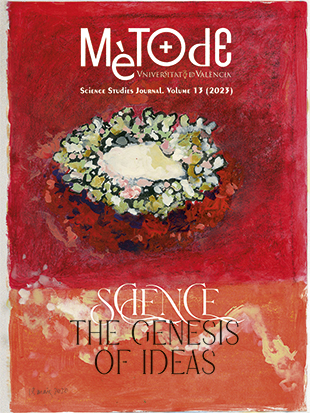Life adapted to precariousness: The ecology of drylands
DOI:
https://doi.org/10.7203/metode.13.22006Keywords:
aridity, droughts, biodiversity, adaptations, desertification Abstract
Abstract
Drylands occupy approximately 40 % of the Earth’s surface. Their peculiar hydrological system, with water as the main limiting factor, together with other characteristics such as the variability of rainfall and their ecological heterogeneity, make these regions one of the main and most relevant sets of biomes on the planet. Beyond their stereotypical conception as places with low economic and ecological profiles, these territories have enormous biodiversity and support 40 % of the world’s population. Global warming is increasing atmospheric aridity, meaning that the strategies developed over millennia by the inhabitants of these areas represent a model we can learn from. Preserving these places is essential to combat climate change, and to do so we must have an in-depth understanding of their structure and functioning.
 Downloads
Downloads
 References
References
Cherlet, M., Hutchinson, C., Reynolds, J., Hill, J., Sommer, S., & von Maltitz, G. (Eds.). (2018). World Atlas of Desertification. Publication Office of the European Union. https://doi.org/10.2760/9205
D’Odorico, P., Bhattachan, A., Davis, K., Ravi, S., & Runyan, C. (2013). Global desertification: Drivers and feedbacks. Advances in Water Resources, 51, 326–344. https://doi.org/10.1016/j.advwatres.2012.01.013
FAO. (2011). Highlands and drylands. (N. Berrahmouni, R. Romeo, D. McGuire, S. Zelaya, D. Maselli, & T. Kohler, Eds.). Food and Agriculture Organization of the United Nations.
FAO. (2019). Trees, forests and land use in drylands: The first global assessment. Food and Agriculture Organization of the United Nations. https://www.fao.org/3/ca7148en/ca7148en.pdf
FAO. (2021). The state of the world’s land and water resources for food and agriculture. Systems at breaking point. Synthesis report. Food and Agriculture Organization of the United Nations. https://doi.org/10.4060/cb7654en
Hewitt, K. (1997). Regions at risk. A geographical introduction to disasters. England. Longman.
Le Houérou, H. N. (1984). Rain use efficiency: A unifying concept in arid-land ecology. Journal of Arid Environments, 7, 213–47.
Lucatello, S., & Huber-Sannwald, E. (2020). Sustainable Development Goals and drylands: Addressing the interconnection. In S. Lucatello, E. Huber-Sannwald, I. Espejel, & N. Martinez-Taguena (Eds.), Stewardship of future drylands and climate change in the Global South (pp. 27–40). Springer.
Maestre, F. T. (2012). Plant species richness and ecosystem multifunctionality in global drylands. Science, 214, 214–218. https://doi.org/10.1126/science.1215442
Maestre, F. T., Benito, B. M., Berdugo, M., Concostrina-Zubiri, L., Delgado-Baquerizo, M., Eldridge, D. J., Guirado, E., Gross, N., Kefi, S., Le Bagousse-Pinguet, Y., Ochoa-Hueso, R., & Soliveres, S. (2021). Biogeography of global drylands. New Phytologist, 231(2), 540–558. https://doi.org/10.1111/nph.17395
Maestre, F. T., Salguero-Gomez, R., & Quero, J. L. (2012). It is getting hotter in here: Determining and projecting the impacts of global environmental change on drylands. Philosophical Transactions of the Royal Society B: Biological Sciences, 367(1606), 3062–3075. https://doi.org/10.1098/rstb.2011.0323
Martinez-Valderrama, J. (2016). Los desiertos y la desertificación. Ediciones Catarata.
Millenium Ecosystem Assessment (MEA). (2005). Drylands. In R. Hassan, R. Scholes, & N. Ash (Eds.), Ecosystems and human well being: Scenarios (pp. 623–662). Island Press.
Mirzabaev, A., Wu, J., Evans, J., Garcia-Oliva, F., Hussein, I. A. G., Iqbal, M. M., Kimutai, J., Knowles, T., Meza, F., Nedjraoui, D., Tena, F., Turkeş, M., Vazquez, R. J., & Weltz, M. (2019). Desertification. In J. M. P. R. Shukla, J. Skea, E. Calvo Buendia, V. Masson-Delmotte, H.-O. Portner, D. C. Roberts, P. Zhai, R. Slade, S. Connors, R. van Diemen, M. Ferrat, E. Haughey, S. Luz, S. Neogi, M. Pathak, J. Petzold, J. Portugal Pereira, P. Vyas, E. Huntley, ... J. Malley (Eds.), Climate change and land: An IPCC special report on climate change, desertification, land degradation, sustainable land management, food security, and greenhouse gas fluxes in terrestrial ecosystems (pp. 249–343). UNEP. https://www.ipcc.ch/srccl/chapter/chapter-3/
Plaza, C., Zaccone, C., Sawicka, K., Mendez, A. M., Tarquis, A., Gasco, G., Heuvelink, G. B., Schuur, E. A. G., & Maestre, F. T. (2018). Soil resources and element stocks in drylands to face global issues. Scientific Reports, 8(1), 1–8. https://doi.org/10.1038/s41598-018-32229-0
Reynolds, J. F., Kemp, P. R., Ogle, K., & Fernandez, R. J. (2004). Modifying the –pulse-reserve– paradigm for deserts of North America: Precipitation pulses, soil water, and plant responses. Oecologia, 141, 194–210. https://doi.org/10.1007/s00442-004-1524-4
UN. (2015, 25 September). General Assembly Resolution 70/1, Transforming Our World: The 2030 Agenda for Sustainable Development, A/RES/70/1. http://undocs.org/A/RES/70/1
UNCCD. (2017). The global land outlook (1st ed.). United Nations Convention to Combat Desertification.
UNEP-WCMC. (2007). A spatial analysis approach to the global delineation of dryland areas of relevance to the CBD Programme of Work on Dry and Subhumid Lands. Dataset based on spatial analysis between WWF terrestrial ecoregions (WWF-US, 2004) and aridity zones (CRU/UEA; UNEPGRID, 1991). Dataset checked and refined to remove many gaps, overlaps and slivers (July 2014).
Vanham, D., Alfieri, L., Florke, M., Grimaldi, S., Lorini, V., Roo, A. De, & Feyen, L. (2021). The number of people exposed to water stress in relation to how much water is reserved for the environment: A global modelling study. Lancet Planet Health, 5, 766–774. https://doi.org/10.1016/S2542-5196(21)00234-5
Downloads
Published
How to Cite
-
Abstract1809
-
PDF618
Issue
Section
License
![]()
All the documents in the OJS platform are open access and property of their respective authors.
Authors publishing in the journal agree to the following terms:
- Authors keep the rights and guarantee Metode Science Studies Journal the right to be the first publication of the document, licensed under a Creative Commons Attribution-NonCommercial-NoDerivatives 4.0 International License that allows others to share the work with an acknowledgement of authorship and publication in the journal.
- Authors are allowed and encouraged to spread their work through electronic means using personal or institutional websites (institutional open archives, personal websites or professional and academic networks profiles) once the text has been published.





